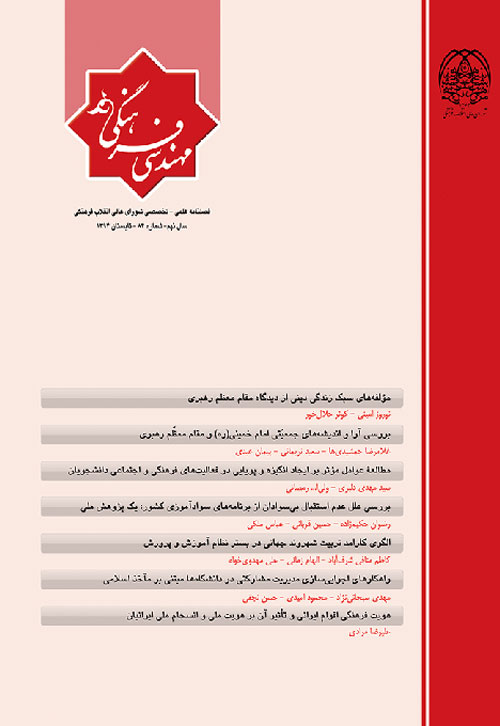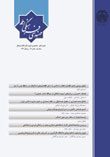فهرست مطالب

فصلنامه مهندسی فرهنگی
پیاپی 84 (تابستان 1394)
- تاریخ انتشار: 1394/07/23
- تعداد عناوین: 7
-
Page 10Intellectuals study “the Life Style” concept in two major theoretical (values & identity) and concrete (consumption & entertainment) features that the most important of which is consumption. But are the consumption features in an Islamic society which is based on faith in the invisible world and afterlife similar to the western models? If not, by using which components does the lifestyle in an Islamic society become manageable? Since the lifestyle has close relation with culture, society, ethics, ideology, personality, identity, consumption and need and on the other hand passive acceptance and western lifestyle stability with its secular source for Muslim society, will lead to lose one’s identity and personal independence, so that study about Islamic lifestyle components becomes so much important. The research will classify and present main religious lifestyle components from the Supreme Leader of Islamic Revolution point of view in 5 main scopes such as intellection, personal attitude, family, social attitude and business.Keywords: Supreme Leader of the Islamic revolution, Iranian Lifestyle, Islam, Religious lifestyle, consumption model
-
Page 30The main objective to write the article is to study Imam Khomeyni and Supreme Leaders’ opinions and demographic thoughts. To achieve research objectives and also data extraction in attributive way, some of Imam Khomeyni and Supreme Leaders’ point of views in demographic scope were studied. In the analysis of Imam Khomeyni’s demographic opinions, concepts such as Marriage and reproduction, population growth, birth control and contraception and abortion, and in Supreme Leader’s demographic opinions analysis, the necessity of young population growth have been mentioned. At the end, some suggestion is presented in order to have complete and integrated study according to Imam Khomeyni and Supreme Leaders’ demographic viewpoints.Keywords: Imam Khomeyni, Supreme Leader, Opinions, Thoughts, Population
-
Page 42The level of interest that college students show in doing multiple student institutions’ programs, is among the most important parameters in the quantitative and qualitative growth of the cultural activities which are carried out by these institutions not to mention the role they play in the favorable carry-out of such programs. Creating motivation and interest among students and consequently their participation in these programs, prepare ground for the cultural ascent and a better functioning of the students in cultural circles and arenas. In this article, the most important impetuses that encourage students to actively participate in these programs and their subsequent effects are analyzed and studied in details. In the article at hand, a descriptive-analytical method has been used within a strategic-experimental outlook and with the aim of creating liveliness in students’ institutions as well as upgrading the qualitative and quantitative level of their activities. Moreover, the effective factors in the creation of such incentives have been found as follows: Identification of the students’ needs and preparing ground for the realization of such needs, holding skill-training courses, utilizing the novel tools of virtual world, development-based and accountable view toward students institutions, cultural creativity and innovation in addition to entrepreneurship, expanding the participation of active student groups and strong cultural planning next to creating an archive of professional experiences.Keywords: motivating, creating liveliness, cultural, social activities
-
Page 64The objective of the research at hand is studying the reasons of Iran’s illiterate populations’ disinterest in the country’s educational programs; a national research. The statistical society of the research includes all the illiterate adults of the country (10 to 49 years of age) as well as the country’s educators. The participants’ number of each sample research was 384 people who were selected from four provinces, namely Sistan and Baluchstan, West Azerbaijan, Golestan and Qom, through anmixed sampling method. The method and the instrument of collecting information are: questionnaire, documents and semi-organized interviews. In the research, for the narrative calculation of the test, we used content narration and for the final calculation of the test, Kronbach’s Alpha was made use of. The final quotient was calculated as 85 for the illiterate and 90 for the educators. The data of the research were analyzed through T-Hitiling Test. The findings of the research show that according to the qualified ones who could take part in literacy programs, the main reasons of disinterest would be the course objective, literate awareness, place of residence, facilities, timing, job and family matters and awareness of the literacy programs. The educators, on the other hand, recounted its reasons as follows: course objective, facilities and timing, the adaptation of the course to the learning principles of adults, evaluation and feedback, content, support and backup, linguistic matters, organizational regulations and the place of residence. Moreover, after scrutinizing the practical evidence and the observations of the problems of the illiterate, they were categorized into two groups and for each a set of solutions were offered in order to obviate the illiteracy problems of the country.Keywords: disinterest, literacy programs, illiteracy, literacy problems
-
Page 84The mission of education in all courses has been training human generations to meet the needs of communities. In the meantime, citizenship education is an important issue. With the passage of time and changes ongoing, individual and local needs have gone beyond, and in relation to other communities common needs have emerged, as a result, concerns of educational systems, have got a wide range; to the extent that in the era of globalization, people have got common needs. In such circumstances, the Education System have to help students with the knowledge, attitude and skills acquisition, besides the general and specialized training, to be able to deal with the conditions and requirements of the era of globalization, in order to have dynamism. The purpose of this paper is to provide an efficient model of global citizenship education in the context of the Education System which has been written by the descriptive- analytical method and according to studies and theoretical principles. The results of this study suggest that not only should the education train the students to live in their own society and internalize the values and norms, but also train them to live in the global society. Thus, educational organizations of schools will be successful in achieving their goals and policies, only if they are able to train aware, responsible and creative citizens in local, national and international societies; and this will not be possible except through global citizenship education in the form of providing opportunities for students to play appropriate roles, by citizenship index charts, applicable to schools.Keywords: global citizenship, global citizenship education, the education system, efficient model
-
Page 106The dynamism of university system in order to achieve the goals of higher education, relies on the creation of appropriate institutional space, creating a spirit of trust, accountability, public participation of managers in the administration of the universities and to strengthen the participatory management culture, in order for the efficient use of financial, material and human resources and also physical spaces to provide the efficiency and productivity of the organization. This descriptiveanalytical article aims to investigate the strategies for the implementation of participatory management in universities using Islamic sources. The results have shown that: 1) based on Islamic verses and hadiths, division of labor, authority cession, group management and decentralization are the principal factors in participatory management. 2) Inappropriate organizational culture, labor allocation, lack of decentralization, wrong authority cession, and dictatorship of senior managers, are the barriers to application of the participatory management. 3) Strategies for the operationalization of participatory management in universities include structure, orientation, process and feedback.Keywords: participatory management, implementation strategies, universities, Islamic sources
-
Page 128In this research, the role of the Iranian ethnic groups’ cultural identity have been studied with analysis approach considering national identity and national unity and its improvement. Historical past, ancestral epic, ancestors land, mother tongue, tribal beliefs and traditions, national causes of glory, religious leaders, ethnic fanaticism, art and inherited literature shape “cultural identity”. Ethnic identity is attributed to such a social identity that is smaller than a big society in which blood ties, ancestral or mythical correlation have provided the causes to relate them based on the social and political hierarchy. Iranians cultural identity and Iranian ethnic groups can be divided into 5 main scopes such as language, religion, cultural geography, history and historical memory and social regime. National identity is a kind of a person›s commitment and attachment emotion to the national society that leads the society to be united. National unity also means coordination and unity among the necessary components of a political and social regime and it is one of the power and national security features. Considering current cultural diversity in Iran’s cultural atmosphere, it is obvious that influential role of the ethnic group and their cultural and tribal identity which shape cultural, national identity and national unity cannot be ignored. Acceptance of ethnic groups’ cultural diversity, and respecting their cultural differences and using cultural synergy, we can significantly help to strengthen the basis of cultural and national identity and Iranian national unity by using differences and similarities of different cultures.Keywords: cultural identity, tribal identity, national identity, national unity


